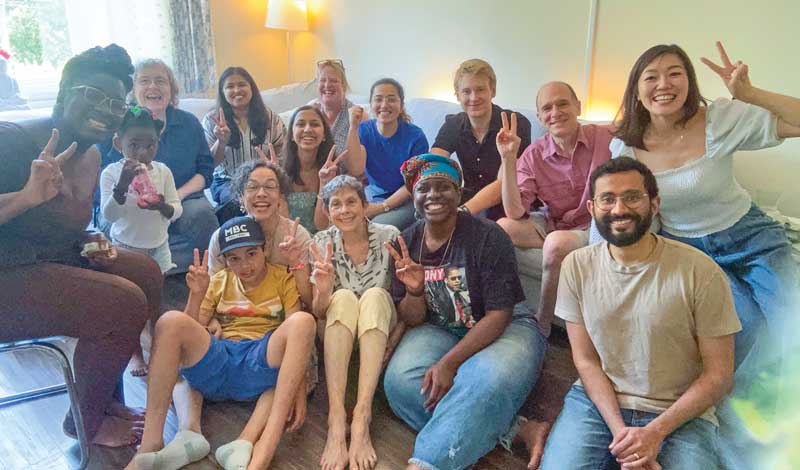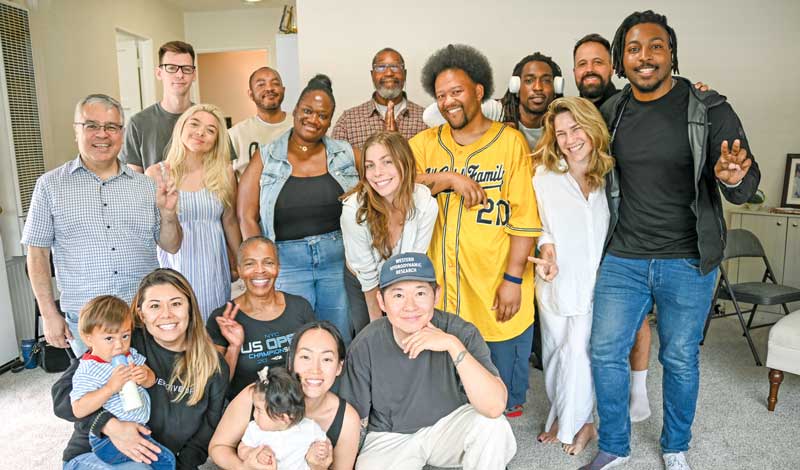Please base your monthly discussion meeting study on one of the following:
1) Buddhist Concepts (pp. 42–43)
2) Writings for Discussion Meetings (pp. 44–45)
3) Material from any recent issue of the World Tribune or Living Buddhism
Buddhist Concepts
Equality in Buddhism
People’s tendency to judge others might stem from our ancestors. To survive, they had to quickly decide whether someone was a threat. Today, this instinct can show up in how we evaluate others based on appearance, education, job status, wealth or other superficial traits. Left unchecked, such judgments can become habits that fuel conflict, social unrest and even war.
Nichiren Buddhism, based on the Lotus Sutra, offers a powerful counterpoint: that all people are fundamentally equal. This view is rooted in the belief that everyone possesses the Buddha nature—the limitless potential for enlightenment.
Many pre-Lotus Sutra teachings denied this potential to certain groups, including women and evil people. And even those who acknowledged universal Buddhahood often taught that it would require countless lifetimes of arduous Buddhist practice to achieve it.
Thankfully, the Lotus Sutra breaks through these limitations, teaching that anyone can immediately awaken to our Buddha nature through sincere Buddhist practice. Nichiren Daishonin made this path accessible to all, empowering each person to shine with the dignity and limitless potential that we equally share.
The Dragon Girl’s Story—‘One Example That Stands for All the Rest’
The Lotus Sutra’s 12th chapter illustrates this point with the story of the dragon girl. As an 8-year-old female with the physical form of an animal, she was subject to intense discrimination. Yet she appeared at the sutra’s ceremony before the assembly of Buddhas and bodhisattvas and offered a precious jewel to the Buddha, who immediately accepted it. She proclaimed to all who were gathered: “Watch me attain Buddhahood!”[1]—and did so immediately.
Taught during a time when women were seen as inferior, this story made a revolutionary statement: that anyone can attain Buddhahood, just as they are.
Nichiren Daishonin called the dragon girl’s story “one example that stands for all the rest.”[2] Her enlightenment opened the way for all people to reveal their Buddhahood.
Lasting Change Begins Within Each Person’s Heart
The Lotus Sutra’s message of equality was on Ikeda Sensei’s mind when he arrived in Los Angeles on August 14, 1965, just days after unrest erupted in the city’s Watts neighborhood.
Three days earlier, police had arrested Marquette Frye during a traffic stop, along with his brother and mother. Outraged by the arrests and long-standing injustices, Black residents took to the streets. Over six days, protests involving some 30,000 people escalated into violent clashes with police and National Guard troops, resulting in 34 deaths, over 1,000 injured and millions of dollars in property damage.
Determined to visit Los Angeles amid this turmoil, Sensei reflected:
“Why did this crisis occur? It’s clearly because of the injustice of racial discrimination. …
“But why is it that discrimination persists, even though equality is now guaranteed by law? The reason is because discrimination resides in people’s hearts. To become a nation of true freedom and democracy, the United States must move forward from reforming its laws to reforming the hearts of its people. …
“Only Buddhism can realize such a reformation of people’s hearts, a reformation of their inner state of life.”[3]
No matter how noble our ideals, they only take root when we live and share them.
Buddhism offers tools to reform our hearts and build a foundation for equality and respect. By chanting Nam-myoho-renge-kyo, we awaken our Buddha nature and begin to believe in the dignity and value of each person’s life. Through our daily Buddhist practice, we learn, in practical terms, how to treasure ourselves and all those around us. And as we change, we naturally inspire change in those around us.
In a society still marked by inequality and division, Nichiren Buddhism reminds us that real, lasting change begins within. When we awaken to our own Buddha nature and see it in others, we start dismantling the walls of judgment and prejudice. That’s how we begin building a world of genuine respect and equality.
—Prepared by the SGI-USA Study Department

Writings for Discussion Meetings
Becoming Invincible: Chanting Through Every Suffering and Joy
Passage
Suffer what there is to suffer, enjoy what there is to enjoy. Regard both suffering and joy as facts of life, and continue chanting Nam-myoho-renge-kyo, no matter what happens. How could this be anything other than the boundless joy of the Law? Strengthen your power of faith more than ever.
—“Happiness in This World,” The Writings of Nichiren Daishonin, vol. 1, p. 681
Background
In 1276, Nichiren Daishonin wrote this letter, “Happiness in This World,” to his disciple Shijo Kingo, explaining the true nature of happiness.
At the time, Kingo’s colleagues had spread false rumors about him to his lord, undermining his trust in Kingo. Aware of this, Nichiren writes in this same letter: “Though worldly troubles may arise, never let them disturb you. No one can avoid problems, not even sages or worthies” (WND-1, 681).
We all experience problems in life, and many tend to equate problems with suffering. Yet Nichiren advises us to remain unshaken by the turbulence of life and chant Nam-myoho-renge-kyo through everything in order to experience the “boundless joy of the Law.”
When we strengthen our belief in the Gohonzon and chant with the conviction that our prayers will without fail be answered, we can bring forth our inherent power to transform any suffering into joy and joy into even greater joy.
—Prepared by the SGI-USA Study Department
Ikeda Sensei’s Encouragement
Continuing Faith Is the Key to Happiness
We must continue chanting Nam-myoho-renge-kyo during times of both suffering and joy. The emphasis here is on the word continue, and it is key that we do so throughout “both suffering and joy.” When confronted with suffering, we must not retreat. We should “suffer what there is to suffer.” This is neither resignation nor escapism. We need to fix our gaze unflinchingly on reality and bravely challenge it based on chanting Nam-myoho-renge-kyo. Nichiren is explaining that this is the correct attitude for practitioners of the Mystic Law. Faith in Nichiren Buddhism is constantly directed toward transforming reality.
Of course, such a state of life is not gained overnight. But if we steadfastly and diligently continue making efforts to polish ourselves day in and day out, month after month, year after year, we will naturally and surely come to attain it, mirroring the words of the sutra passage “This cluster of unsurpassed jewels / has come to us unsought” (The Lotus Sutra and Its Opening and Closing Sutras, p. 124).[4]Next, “enjoy what there is to enjoy,” can be taken to mean that when we’re experiencing joy, we should remember to have gratitude and make even greater efforts to chant Nam-myoho-renge-kyo, aiming toward the ultimate goal of attaining Buddhahood in this lifetime. Deepening our seeking spirit in faith is much more difficult in good times than in bad, because in good times it is easy to grow lax and self-satisfied. Rather than being someone who is strong in adversity but weak when things are going well, we should seek to construct the kind of invincible faith that allows us to “regard both suffering and joy as facts of life.”
Such strong faith is forged through our practice as Soka Gakkai members striving to achieve the lofty goal of kosen-rufu and our own enlightenment in this existence. Above all, chanting Nam-myoho-renge-kyo—the process by which we “diligently polish our mirror day and night” (see “On Attaining Buddhahood in This Lifetime,” WND-1, 4)—strengthens our lives in the same way that a magnificent sword is forged and tempered. The crux here lies in chanting with the spirit to challenge in times of suffering, and chanting with appreciation in times of joy. (On Attaining Buddhahood in This Lifetime: SGI President Ikeda’s Lecture Series, pp. 41–42)
From the September 2025 Living Buddhism
References
- The Lotus Sutra and Its Opening and Closing Sutras, p. 227. ↩︎
- “The Opening of the Eyes,” The Writings of Nichiren Daishonin, vol. 1, p. 269. ↩︎
- The New Human Revolution, vol. 10, revised edition, p. 79. ↩︎
- These words are an exclamation of joy when Shakyamuni’s voice-hearer disciples learn that they can in fact attain Buddhahood, which had previously been denied to them. ↩︎
You are reading {{ meterCount }} of {{ meterMax }} free premium articles

